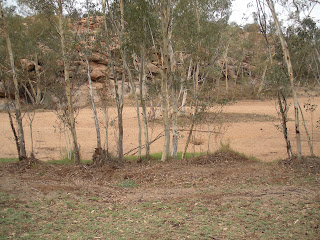Port Augusta- a neat little town nestling near the top of an inlet called the Spencer Gulf, which divides east from west in South Australia. As Betty needs a going over we had decided to stay two nights here, in cabins, and a good job we did for overnight the heavens opened!
Betty was booked in for a new tyre and a full service in a small garage on the outskirts, so while she was there we took the opportunity to look round the town, and it's 'heritage' buildings. The town was founded in the 1830s, and developed in the latter half of that century, so many of the buildings were typical colonial, which we have seen around the world in tropical British colonies.We also spent a couple of hours in the Outback Centre, where we saw a few interesting archive films of the area, and the farmers who created the industry to the north. They had a particularly hard time during long droughts, and many lost their whole livelyhoods and indeed some died as a result. The railway was another interesting exhibit, showing how it was built to the north which allowed the riches of the area to be transported to Port Augusta, which in those days was a thriving seaport, exporting around the world, including Europe.
The rain caught up with us again on the second night- indeed almost the whole of the country was in a downpour, from Broome in the north west to Melbourne in the south east. Floods enveloped Alice Springs and Coober Pedy, as well as many inland towns in Victoria and New South Wales.
Today we had to make a decision- where will the weather be a little better- so we made our way west along the top of the Eyre Peninsula, (which is shaped a little like India) to a little village called Streaky Bay.
On the way we passed through good farming country, mostly arable, but with some sheep. Many of the 'fields' were huge, covering many square miles.Every ten miles or so we saw massive grain silos alongside a railway, and in the small towns along the way we noticed dealerships for farm machinery.
In one small town was a monument to the Farmer, standing 10 metres high
This little town boasts a good fishing jetty, if we get a bit of time in the morning we might try a bit of that.
































